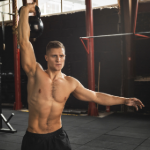By Houston Smith, DC
Multi-Joint Approach
Quality over quantity is a tale as old as time. Would you rather buy a pair of new boots from a true craftsman, or the discount shelf at Walmart? The craftsman uses high quality materials that last for decades, while the latter wants to make a quick buck. This is how one should think about rehab and exercise. Choose quality methods and learn skills that will transfer to every day activities.

It’s important to have a plan tailored to your specific needs. The direction and training volume are important predictors of success. Focus on global movement patterns that work across several different joints. A few examples include: kettlebell windmills, Turkish get ups, and single leg RDLs. With multiple joints working together, you are more efficient with your time and a rhythm can be established.
Our bodies learn best through repeatable, fluid movements. Further, we can speed up or slow down the movement to create a more challenging session. Another benefit of working multiple joints simultaneously is the synergistic effect on muscle groups and soft tissues. Stop training ‘splits’ and focus on full body all the time. When the body is performing a task like a fluid exercise, the body will develop muscle memory and better coordination. The solution is in the pattern. Like a musician playing the piano, there are certain patterns and chords that are memorized to put songs together. Rehab is not much different. You learn best by doing the work in chunks or pieces and then working on combining the parts into a fluid whole. Learning to use this valuable method of training will improve the central nervous system and allow natural stabilization to occur.
Holistic Benefits
Effective rehabilitation goes beyond physical recovery. Quality rehab exercises can improve mental health through endorphin release, and brain derived neurotrophic factor (BDNF). We always encourage rehab exercises that improve brain-muscle connections and target problems areas like the neck, shoulders, hips, and lower back. The benefits of rehab outlast the session with sustained effects throughout the day.
Conclusion
Quality rehab exercises are a vital component of effective recovery. By learning and practicing rehab skills, our physical bodies will heal naturally and become resilient. Our job as your healthcare provider is to focus on individualized care, while addressing the root cause of your problem without the use of drugs or surgery.
